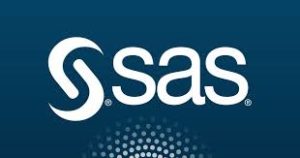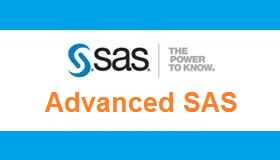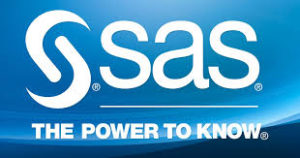Clinical SAS
Clinical SAS
Clinical SAS:

What is SAS:
SAS (Statistical Analysis System) is software developed by SAS Institute for advanced analytics, multivariate analyses, business intelligence, data management, and predictive analytics.
SAS is widely used in clinical trial data analysis in pharmaceutical, biotech and clinical research companies.
SAS programmers play an important role in clinical trial data analysis.
SAS software has proved itself as the market leader in providing a new generation of business intelligence software and services that creates true enterprise intelligence.
The SAS Institute is the world’s largest privately held software company.
It is also the only vendor that completely integrates leading data warehousing, analytics and traditional BI applications, to create intelligence from massive amounts of data.
Future of SAS:
SAS has a large part to play in the future of analytics and big data.
Today everyone in the business world must be aware of the benefits of having SAS skills and understand why these skills are in demand in current and future markets.
As someone with SAS expertise,
Why to learn SAS:
The big advantage of learning SAS is that it is a fourth generation language.
It is fun learning SAS. It provides GUI and an easy way to access multiple applications.
It relies on user-written scripts or “programs” that are processed when requested to know what to do.
Because it is a script-based application, the key to being successful using SAS is learning the rules and tricks of writing scripts.
It works with large data and generate graphs and report.

Base SAS
CONTENT:
• Basic Five Main Windows: Explorer, Program Editor, Log, Output and Result Windows
• User Enhanced Editor Windows
• MANAGE YOUR SAS WINDOWS
• Manage your SAS Windows
• Create SAS Libraries
• Explore and Manage SAS Files
• Enter and Submit SAS Programs
• Create and Use File Shortcuts
BASIC CONCEPTS:
• The Steps Involve in Processing SAS Programs
• Structure and Component of SAS Dataset
• Temporary and Permanent SAS Libraries
• Reading the SAS Log
• Using SAS System Option
READING RAW DATA:
• Reference a SAS Data Library
• Reference a Raw Data File
• Name a SAS Data Set to be Read
• Specify a Raw Data File to be Read
• Read Standard Character and Numeric Values in Fields
• Submit and Verify a Data Step Program
• Distinguish Between Standard and Nonstandard Numeric Data
• Read Standard Field Data
• Read Non Standard Field Data
• Free-Format Data Separated by Nonblank Delimiters, Such as Commas
• Free-Format Data that Contains Missing Values
• Character Values that Exceed Eight Characters
• Character Values that Contain Embedded Blanks
• Controlling Input with Options in the in File Statements
CREATING MULTIPLE OBSERVATION FROM A SINGLE RECORD:
• Create Multiple Observation from Single Record that Contains Repeating Blocks of Data
• Hold the Current Record across Iterations of the Data Step
• Hold the Current Record for the next input Statement
• Execute SAS Statements based on a Variable’s Value
• Explicity Write an Observation to a Data Set
• Execute SAS Statement while a Condition is True
GENERATING DATA WITH DO LOOPS:
• Construct ado Loop to Perform Repetitive Calculation
• Control the Execution of do Loop
• Generate Multiple Observations in one Iteration of the Data Step
• Construct Nested do Loops
READING DATE AND TIME VALUES:
• How SAS Software Stores Date and Time Values
• To Read Common Date and Time Expression Using SAS Informats
WORKING WITH SAS DATA:
• Identify the Two Phases that Occur when a Data Step is Processed
• Identify the Processing Phase in which an Error Occur
READING,CONCATENATING AND MERGING SAS DATA SETS:
• Create a New Data Set from One or More Existing Data Set
• Select Observation based on a Condition
• Select Variables TI Include or Exclude
• Using if then Statements
• Grouping Observation with if – then/Else Statements
• Sub Setting your Data
• Selected Date Informats, Formats
• Using the Retain and Sum Statements
• Using Shortcuts for Lists of Variable Names
• Using SAS Data Set Options
• Tracking and Selecting Observations with the in= Option
• Writing Multiple Data Sets Using the Output Statement
• Making Several Observations from One Using the Output Statement
TRANSFORMING DATA WITH SAS FUNCTIONS:
• Convert Character Data to Numeric Data
• Convert Numeric Data to Character Data
• Create SAS Date Values
• Extract the Month and year from A SAS Date Value
• Extract, Edit and Search Character Variable Values
SAS PROCEDURES:
• Specify SAS Data Sets to Print
• Select Variables and Observations to Print
• Specify Column totals for Numeric Variables
• Sort Data by Values of One or more Variables
• Assign Descriptive Labels to Variables
• Double Space SAS Listing Output
Append Procedure Plot Procedure
Compare Procedure Print Procedure
Contents Procedure Datasets Procedure
Export Procedure Format Procedure
Freq Procedure Import Procedure
Means Procedure Printto Procedure
Report Procedure Sort Procedure
Summary Procedure Tabulate Procedure
Transpose Procedure Univariate Procedure
CREATING LIST REPORTS:
• ? The Variables to Appear in your Table
• ? The Statistic to be Computed for Each Variable
• ? The Arrangement of Statistic and Variable in the Table
• ? Additional Features Such as Formats for Values in the Table,Column and Row Totals and Labels for Statistics and Summary Variable
• ? Creating Plots
• ? Creating Vbar, Hbar,Block and Pie Charts
• ? Enhancing Reports
• ? Enhancing and Exporting Charts and Plots
• ? Enhancing your Output with Ods
• ? Using Ods Statements to Create HTML
• ? Using Ods Statements to Create RTF, PDF
Advance SAS: 
SAS / MACROS
UNDERSTANDING THE CONCEPTS AND FEATURES OF MACRO PROGRAMMING:
• ? What is SAS Macro Facility?
• ? What are the Advantages of Sas Macro Facility?
• ? Where can the Sas Macro Facility be Used?
• ? Examples of the SAS Facility
• ? Comparing Macro Language Processing and SAS Language Processing
• ? Processing a SAS Program that Contains Macro Language
MACRO PROGRAMS:
• ? Creating Macro Programs
• ? Executing a Macro Program
• ? Passing Values to a Macro Program through Macro Parameters
MACRO EXPRESSION AND MACRO PROGRAMMING STATEMENTS:
• ? Constructing Macro Expression
• ? Conditional Processing with the Macro Language
• ? IterationProcessing with the Macro Language
• ? Branching in Macro Processing
MACRO VARIABLE:
• ? Basic Concept of Macro Variable
• ? Referencing Macro Variables
• ? Understanding Macro Variables
• ? Displaying Macro Variable Values
• ? Understanding Automatic Macro Variables
• ? Understanding Userdefined Macro Variables
• ? Combining Macro Variables with Text
• ? Referencing Macro Variables Indirectly
MACRO LANGUAGE FUNCTIONS:
• ? Macro Character Functions
• ? Macro Evaluation Functions
• ? Macro Quoted Functions
APPLYING YOUR KNOWLEDGE OF MACRO PROGRAMMING:
• ? Storing and Reusing Macro Programs
• ? Debugging Macro Programming
• ? Understanding the types of Error that can occur in Macro Programming
SAS / SQL
INTRODUCTION TO THE SQL PROCEDURE:
• ? What is SQL?
• ? Terminology
• ? Comparing Proc SQL with SAS Data Step
CREATING AND UPDATING TABLES
• Creating Tables
• Inserting Rows into Tables
• Updating Data Values in Table
• Deleting Rows
• Altering Columns
• Deleting a Table
• Using SQL Procedure tables in SAS Software
• Using PROC SQL with the SAS MACRO Facility
• Creating and Using MACRO Variables in SQL
RETRIEVING DATA FROM A SINGLE TABLE
• Overview of the Select Statement
• Selecting Columns in Table
• Creating New Columns
• Sorting Data
• Retrieving Rows that Satisfy a Condition
• Summarizing Data
• Grouping Data
